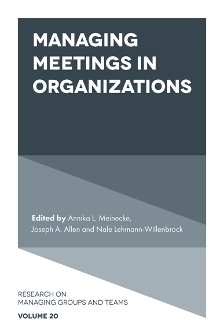
Index
Managing Meetings in Organizations
ISBN: 978-1-83867-228-7, eISBN: 978-1-83867-227-0
ISSN: 1534-0856
Publication date: 17 March 2020
Citation
(2020), "Index", Meinecke, A.L., Allen, J.A. and Lehmann-Willenbrock, N. (Ed.) Managing Meetings in Organizations (Research on Managing Groups and Teams, Vol. 20), Emerald Publishing Limited, Leeds, pp. 275-278. https://doi.org/10.1108/S1534-085620200000020012
Publisher
:Emerald Publishing Limited
Copyright © 2020 Emerald Publishing Limited
INDEX
Index
- Prelims
- Part I: Conceptual Foundations of Meeting Science
- Chapter 1: The Origins and Evolutionary Significance of Team Meetings in Organizations
- Chapter 2: The Staff Meeting … And Beyond …
- Part II: The Intersection of Individual and Team Processes in Meetings
- Chapter 3: Are Meetings Really Just Another Stressor? The Relevance of Team Meetings for Individual Well-Being
- Chapter 4: Putting the “Group” in Group Meetings: Entitativity in Face-to-Face and Online Meetings
- Chapter 5: Fostering Effective Debriefs: The Integral Role of Team Reflexivity
- Part III: Diversity and Gender in Meetings
- Chapter 6: Social Influence in Meetings: A Gender Perspective
- Chapter 7: Multilevel Antecedents of Negativity in Team Meetings: The Role of Job Attitudes and Gender
- Chapter 8: Faultlines during Meeting Interactions: The Role of Intersubgroup Communication
- Chapter 9: Intergenerational Learning in Age-Diverse Meetings: A Social Comparison Perspective
- Part IV: Leadership and Strategy in and Through Meetings
- Chapter 10: Formal Leadership in Workplace Meetings
- Chapter 11: Meetings as a Facilitator of Multiteam System Functioning
- Chapter 12: Meetings as Organizational Strategy for Planned Emergence
- Index